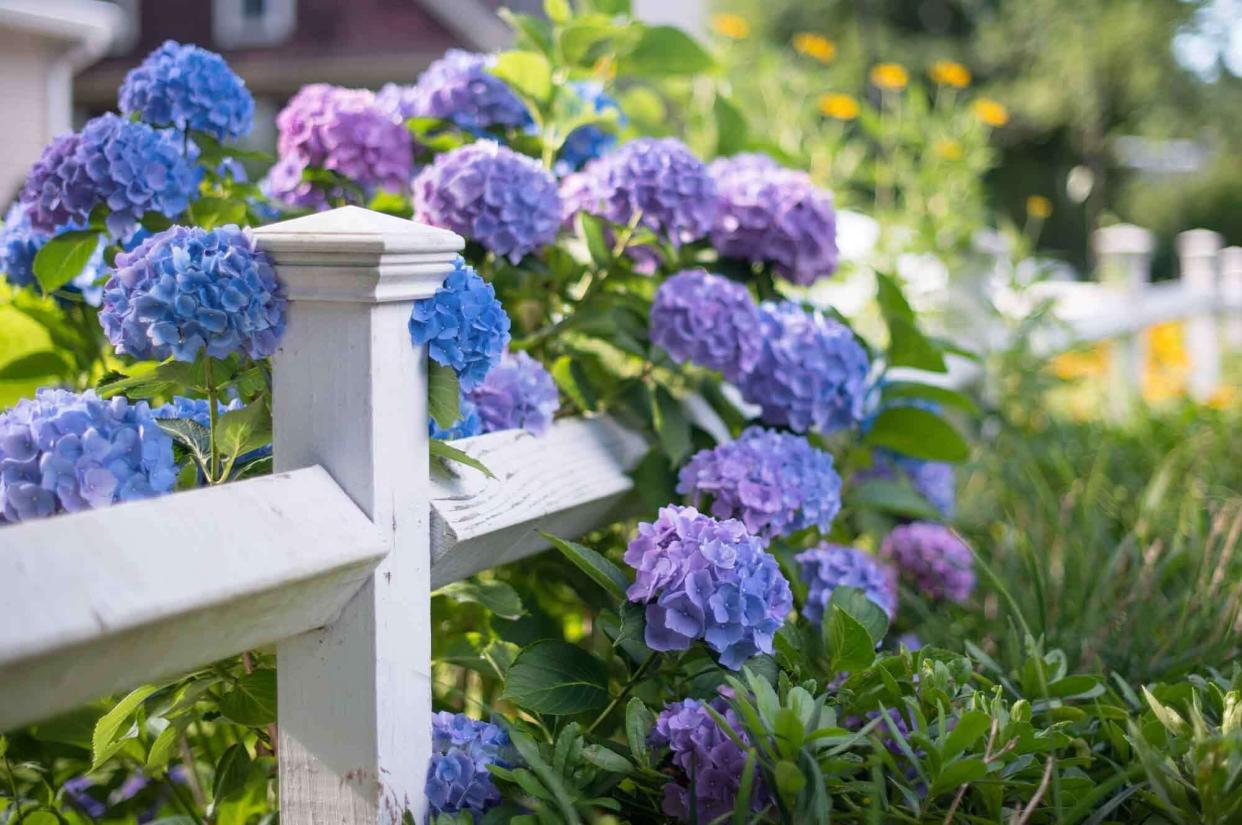Want to Camouflage an Outdated Fence? Plant These 6 Shrubs and Flowers Along Your Property Line

Preappy / Getty Images
If you're looking to camouflage a chain link fence in your backyard or add a lovely backdrop to your garden, planting a combination of shrubs and flowers along your property line will do the trick—and will also provide food sources and a habitat for birds, bees, and butterflies. To help you cultivate this area of your yard, we tapped several landscape designers. Ahead, they share the flowers and shrubs that work best along fences, so you can plant your way to a better-looking partition.
Related: How to Encourage Plants and Flowers to Climb
Climbing Vines
"We recommend planting an assortment of climbing vines that use the fence for support," says Edmund Hollander, President of Hollander Design, noting that he prefers using honeysuckle, trumpet creeper, or climbing roses in this space. Cathy Graham, author of Second Bloom, agrees; she annually plants passionflower vines by the iron fences outside her New York City apartment, since their vines grow vigorously, she says. This ideal fence-lining plant grows quickly and blooms well throughout the summer into early fall—as do Eden climbing roses, Graham's first choice. Their "creamy color with a bit of blush pink in the center is just breathtaking climbing up a grey trellis fence." To set these climbing vines up for success, always remove any damaged, diseased, or overly tangled stems. Then, anchor (and limit) their growth in the direction of your fences to ensure a lush look.
Evergreens
Stephen Eich, Urban Studio Director of Hollander Design, says evergreens are the perfect alternative to climbing vines. Eich recommends Blue Girl hollies, Japanese yew, and boxwood. Although all three supply vital nesting locations, only "the yew and hollies contain berries to serve as a food source," he says. Evergreen shrubs also "provide an architectural delineation of spaces between the garden and tend to be more formal," making them the ultimate fence-lining option for more classically structured yards. To ensure optimal evergreen growth, supply protection and extra support during the winter months—but "the Blue Girl hollies have a stronger branch, allowing it to withstand greater pressure from snow build up," Eich notes.
Berry Flowers
Raspberries, blackberries, and gooseberries also make for stellar fence-lining plants, as "they grow long, fruiting canes that do best when tied to supports," explains Melissa Reavis, Residential Studio Director of Hollander Design. "Fences can provide that support and allow easier access to the berries, since you can fan them across the fence panels," she notes. To start harvesting your berries by the next fruiting season, pick "a location that isn't too exposed to midday sun or lots of wind," Reavis says, warning that "berries are never great the first year!"
Espaliered Fruit Trees
Espaliered fruit is not strictly a shrub, but when training trees in this form, they can be kept much smaller (making them easier to harvest the fruit), summarizes Reavis; they also look lovely when placed along your fencing. "Training espaliers against a fence allows you to use the fence as your support, and the attractive form of the espalier will read much better against the solid backdrop," she explains. "It's best to train these plants against a southern-facing panel. These trees will benefit from the warmth, which will help its fruits ripen faster, extending your harvesting season," Reavis adds.
Plant Shrubs
Fence lines are excellent spots to create habitats for birds, especially since shrubs produce berries, providing "two crucial elements: shelter and food," adds Reavis. "Viburnum, chokeberry, beautyberry, winterberry, and even blueberries are great food sources for birds," she shares. For optimal success with these plant shrubs, Reavis recommends planting several iterations along your now-living fence, "so that you provide a prolonged period of food and attract a large diversity of birds." she says.
Annabel's Hydrangeas
Annabel's hydrangeas, which bloom into pale chartreuse heads, look ethereal "along a fence, swaying in the wind," adds Graham. Eich agrees, noting that these spring to early summer plants add vibrant color to your lawn and become great nesting sites for birds. To care for your hydrangeas, water them well at least once a week (especially during dry weather) and occasionally boost them with a dose of fertilizer once or twice annually in spring or summer.

